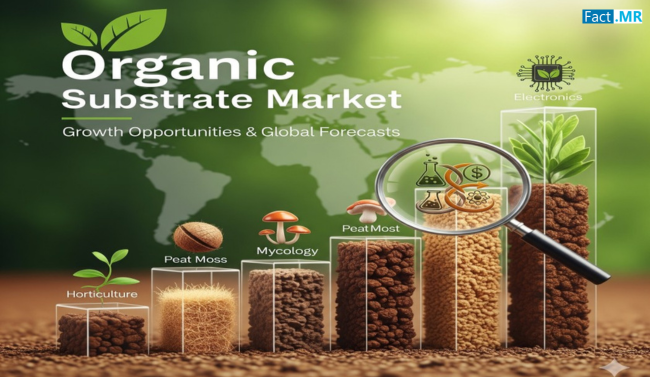Organic substrates are essential components in semiconductor packaging and electronics manufacturing. Acting as the foundation for integrated circuits (ICs) and chips, these materials enable the interconnection and packaging of electronic devices. Unlike ceramic or inorganic substrates, organic substrates are polymer-based and produced using cost-effective, PCB-like manufacturing processes.
As demand for lighter, thinner, and more powerful devices accelerates, the shift towards organic substrates is becoming more pronounced. Their flexibility, affordability, and adaptability make them an increasingly attractive solution across industries ranging from consumer electronics to telecommunications.
Market Overview
The organic substrate market is witnessing significant momentum, propelled by rising adoption in consumer electronics, communication devices, and advanced display technologies.
Organic substrates provide a balance of performance and cost efficiency, though challenges remain with thermal conductivity and durability in high-power applications. Nonetheless, ongoing advancements in material science are steadily improving these characteristics, allowing organic substrates to penetrate new market segments.
Key Market Drivers and Trends
- Growing Demand for Compact Consumer Electronics
The global appetite for sleek, lightweight devices such as smartphones, tablets, and wearables continues to expand. These devices require packaging solutions that minimize size while maximizing performance. Organic substrates enable miniaturization and fine interconnections, making them indispensable for compact electronics.
- Cost Efficiency in Manufacturing
Because organic substrates are manufactured using well-established PCB processes, they are more cost-effective compared to ceramics. This advantage makes them a preferred choice for mass-produced consumer electronics, where cost savings at scale are critical.
- Rise of Flexible Packaging
Flexible substrates, particularly tape-based varieties, are rapidly gaining popularity. They are especially valuable in foldable devices, flexible displays, and compact modules where rigid packaging cannot be applied. Their adaptability positions them as a key growth driver.
- Demand for Dense Interconnects
Modern devices require increasingly complex circuitry in smaller footprints. Packaging solutions such as Small Outline Packages (SOPs) and other fine-pitch technologies depend on organic substrates to meet miniaturization needs without compromising performance.
- Expanding Applications Beyond Mobile Phones
While smartphones dominate demand, organic substrates are also finding use in flat-panel displays, RF modules, IoT devices, and advanced wearables. As integration of multiple functions into single devices grows, substrates are expected to play an even more critical role.
- Thermal Management Challenges
Despite the benefits, organic substrates face limitations in thermal resistance compared to ceramic counterparts. Managing heat dissipation remains a central challenge for manufacturers, especially in high-performance or power-intensive applications.
Market Segmentation
By Substrate Type
- Rigid Substrates: Used where structural stability is vital.
- Tape/Flexible Substrates: Increasingly dominant due to demand for thinner, bendable, and space-saving packaging solutions.
By Packaging Technology
- Small Outline Packages (SOPs): Popular for compact designs and fine interconnects.
- Grid Array Packages, Dual In-Line Packages, Quad Flat Packages, Flat No-Lead Packages: Serving different niches across the electronics spectrum, depending on application requirements.
By Application
- Mobile Phones: The largest application segment, driven by demand for compactness and performance.
- Flat Panel Displays: Substrates play a vital role in advanced display technologies, including OLED and flexible screens.
- Other Consumer Electronics: Including wearables, IoT devices, and RF modules, which are expanding the use cases for organic substrates.
Regional Insights
- Asia-Pacific: Dominates the market due to the strong presence of electronics manufacturing hubs in countries such as China, Japan, South Korea, and Taiwan.
- North America and Europe: Focused on high-reliability applications, advanced R&D, and stringent performance standards in sectors like healthcare and automotive.
- Emerging Economies: Adoption is increasing as consumer electronics penetration deepens, although supply chain and cost factors may affect growth speed.
Competitive Landscape
The market features a mix of global giants and specialized manufacturers. Key players compete on factors such as innovation in materials, cost optimization, miniaturization capabilities, and reliability. Companies are investing in R&D to enhance thermal performance, develop environmentally friendly substrates, and expand production capacity to meet rising demand.
Strategies commonly adopted include:
- Partnerships with semiconductor companies to co-develop solutions.
- Expanding manufacturing capabilities in Asia-Pacific.
- Investing in flexible and high-density packaging technologies.
- Emphasizing sustainability in substrate design and production.
Opportunities and Challenges
Opportunities
- Flexible and Wearable Devices: Rapid growth in foldable phones, smartwatches, and flexible displays opens strong opportunities.
- IoT Expansion: Billions of connected devices require small, efficient, and cost-effective packaging solutions.
- Sustainability Initiatives: Development of recyclable and eco-friendly substrates could become a differentiator.
- Integration in Advanced Packaging: Substrates enabling multi-chip modules and heterogeneous integration are in high demand.
Challenges
- Thermal Limitations: Heat dissipation remains a bottleneck, especially for high-power applications.
- Miniaturization Complexity: Finer line spacing increases risks of defects, impacting yields.
- Competition from Ceramics and Emerging Materials: In high-reliability applications, ceramics may still dominate.
- Supply Chain Constraints: Dependence on raw material availability and consistency can affect production cycles.
Strategic Implications for Businesses
For companies operating in the semiconductor packaging and electronics ecosystem, several strategies are becoming critical:
- Prioritizing Innovation: Investments in material science to enhance performance and reliability of organic substrates.
- Supply Chain Resilience: Building diversified supplier networks and in-house capabilities to manage risks.
- Collaborative Development: Engaging in partnerships with OEMs and device manufacturers to co-create customized solutions.
- Sustainability: Incorporating greener materials and processes to align with global sustainability goals.
- Testing and Reliability Assurance: With tighter packaging and higher thermal stresses, robust testing regimes are essential.
Future Outlook
The organic substrate market is on a growth trajectory, driven by demand for miniaturization, flexible electronics, and cost-effective packaging. While thermal performance challenges persist, innovations in polymer chemistry, adhesives, and interconnects are expected to narrow the gap with ceramic substrates.
Regions with established electronics ecosystems will continue to lead, but emerging economies will increasingly contribute to demand. Companies that can balance affordability, performance, and environmental responsibility will gain a significant edge.
Conclusion
Organic substrates are no longer niche materials; they are at the heart of next-generation electronics packaging. From smartphones to wearables and IoT devices, their role in enabling smaller, thinner, and more efficient devices is undeniable.
As the market evolves, the focus will remain on balancing performance with cost, improving thermal management, and embracing sustainability. Businesses that innovate and adapt will not only thrive in this expanding market but also help shape the future of electronic device manufacturing.



